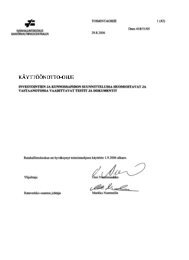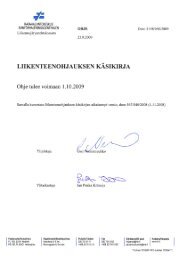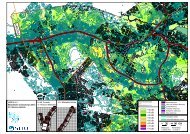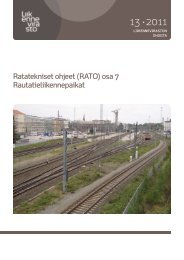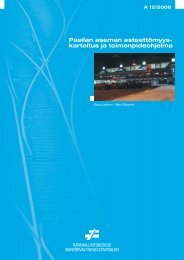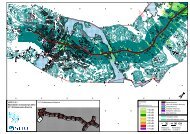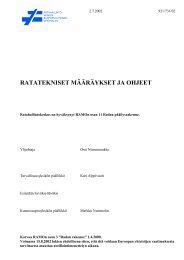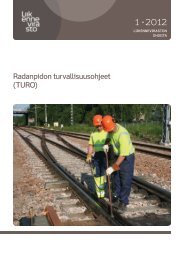Deformation behaviour of railway embankment ... - Liikennevirasto
Deformation behaviour of railway embankment ... - Liikennevirasto
Deformation behaviour of railway embankment ... - Liikennevirasto
Create successful ePaper yourself
Turn your PDF publications into a flip-book with our unique Google optimized e-Paper software.
169<br />
examined for leaks through pinholes. At the same time, the surface <strong>of</strong> the membrane<br />
is inspected visually for any flaws, such as trapped air bubbles that could burst<br />
during the test. The membrane must be discarded if there are any doubts regarding<br />
its sealing capabilities.<br />
− Change in cross-sectional area <strong>of</strong> the specimen → The actual deviatoric stress<br />
applied to the specimen changes during a triaxial test as the cross section <strong>of</strong> the<br />
specimen changes due to radial plastic strain. The cross-sectional area <strong>of</strong> the<br />
specimen, A, at any moment during triaxial testing can be calculated according to<br />
A =<br />
A 0<br />
+ 2πε<br />
R<br />
3, p<br />
2<br />
, [Eq. 8.7.2:1]<br />
where<br />
A 0 = original cross-sectional area,<br />
R = radius <strong>of</strong> the specimen,<br />
ε 3,p = radial permanent strain induced.<br />
The amount <strong>of</strong> plastic strain during a resilient test is practically none, or negligible.<br />
This is due to the fact that, prior to resilient testing, the specimen is brought to a<br />
stable state by conditioning. However, a significant amount <strong>of</strong> plastic strain<br />
accumulates during conditioning and permanent strain tests. For these cases, the<br />
cross-sectional area <strong>of</strong> the specimen should be corrected accordingly.<br />
− Membrane stiffness → The membranes enclosing a triaxial specimen may have a<br />
certain restraining effect on the specimen, thereby reducing the strain caused by the<br />
deviator stress. For specimens <strong>of</strong> high strength materials or with large diameters, the<br />
effect <strong>of</strong> the membrane restraint is considered to be insignificant (Head 1994).<br />
8.7.3 Description <strong>of</strong> the test series performed by Lekarp (1999)<br />
Following the construction <strong>of</strong> the triaxial apparatus, a test program was planned, partly<br />
to evaluate the performance <strong>of</strong> the equipment and partly to characterize the resilient<br />
response <strong>of</strong> several unbound granular materials.<br />
The tests were all conducted in drained condition, thus allowing the pore pressure to<br />
dissipate as the tests proceeded. Each test was performed by the application <strong>of</strong> repeated<br />
deviatoric and confining stresses, while the induced axial and radial strains were<br />
measured.<br />
8.8 Laboratoire des Ponts et Chaussées’ repeated load triaxial apparatus<br />
8.8.1 Introduction<br />
Gidel et al. (2004) proposed a new approach for studying permanent deformation in<br />
unbound granular materials under cyclic loading. The approach is based on results <strong>of</strong><br />
laboratory tests performed with the repeated load triaxial apparatus. The repeated load<br />
triaxial apparatus was developed in order to investigate the mechanical <strong>behaviour</strong> <strong>of</strong>





